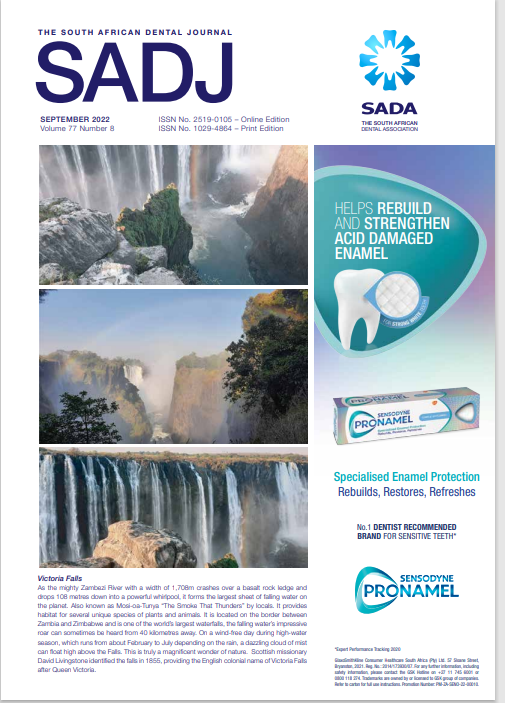Pharmaceutical cost implications for oral healthcare interventions at a dental clinic in Windhoek, Namibia
DOI:
https://doi.org/10.17159/2519-0105/2022/v77no8a3Keywords:
oral health, dental caries, universal healthcare, pharmaceuticals, costs, Namibia.Abstract
Half of the world’s 7.9 billion population suffers from oral health conditions. Most are largely preventable and treatable but costs are often unaffordable especially in developing countries. The World Health Organization (WHO) resolved in 2021 to include oral healthcare interventions in universal healthcare coverage (UHC) programmes. Although the general expenditure on oral healthcare services has been reported by some countries, amounts spent on particularly pharmaceuticals have not been reported. This study aimed to report on the prevalence of different types of oral health diseases in patients attending a dental clinic in Windhoek (Namibia) and quantify the pharmaceutical expenditure incurred. Records for all patients who visited the dental clinic at KIRH during a six-month period (1 January 2021 to 30 June 2021) were reviewed. Costs associated with the respective pharmaceutical management options for the most common oral conditions were calculated based on the approximated cost for a single treatment course per patient.
Pharmaceutical expenditure on oral diseases was approximately 0.4% of the hospital’s annual budget. From this, 94.6% was due to treatment of dental caries which had a 90.1% prevalence. Prevalence of dental caries among 13-19 years age group (9.5%) was lower than for 1-12 years (18.6%) and 20-64 years (68.2%). Cases for dental caries were fewer for the 65+ years age group (3.8%
of total cases) but had the highest prevalence (95.2%) of dental caries then other age groups. The proportion of the pharmaceutical budget spent on treating oral diseases was 0.4%, of which 94.6% was due to dental caries. Promotion of oral healthcare
among children may be instrumental in reducing the pharmaceutical costs associated with treatment of dental carries.
Downloads
References
James SL, Abate D, Abate KH, Abay SM, Abbafati C, Abbasi N, et al. Global, regional, and national incidence, prevalence, and years lived with disability for 354 Diseases and Injuries for 195 countries and territories, 1990-2017: A systematic analysis for the Global Burden of Disease Study 2017. Lancet. 2018;392(10159):1789–858.
World Health Organization. Proposed Resolution on Oral health 2021 [Internet]. Zurich; 2021. Available from:https://www.who.int /news/item/27-05-2021-world-health-assembly-resolution-paves-the-wayfor-better-oral-health-care
World Health Organization. Consolidated report by the Director-General 1. Vol. 2030, Seventy-fourth World Health Assembly. 2021.
World Health Organization. The world health report 2010. Health systems financing: the path to universal coverage. Zurich; 2010.
OCDE. Health at a Glance 2017: Chartset [Internet]. European Observatory on Health Systems and Policies (2017). 2017. Available from: https://www.oecd-ilibrary.org/social-issues-migration-health/health-at-a-glance-2017_health_glance-2017-
World Bank. Namibia Health Sector Public Expenditure Review [Internet]. 2019. Available from: https://documents1.worldbank.org/curated/
en/268141563376806867/pdf/Namibia-HealthSector-Public-Expenditure-Review.pdf
World Health Organization. Namibia [Internet]. Available from: https://www.who.int/countries/nam/
World Bank. Namibia At-A-Glance [Internet]. Available from: https://www.worldbank.org/en/country/namibia
Ozawa S, Shankar R, Leopold C, Orubu S. Access to medicines through health systems in low-and middleincome countries. Health Policy Plan. 2019;34:III1–3.
Political Declaration of the High-level Meeting of the General Assembly on the Prevention and Control of Noncommunicable Diseases. 2011.
Subrata S, Subrata S. Prevalence and severity of dental caries and oral hygiene status in rural and urban areas of Calcutta. J Indian Soc Pedod Prev Dent. 1996;14:17–20.
Jaiswal D, Kalia P, Hiremath S, Singh AK, Pani P, Kumar N. Evaluation of oral hygiene status among 12-14 year-old school children. J Pharm Bioallied Sci. 2021;13(Suppl 1):S112–5.
Tickle M, O’Neill C, Donaldson M, Birch S, Noble S, Killough S, et al. A randomised controlled trial to measure the effects and costs of a dental caries prevention regime for young children attending primary care dental services: The Northern Ireland caries prevention in practice (NIC-PIP) trial. Health Technol Assess (Rockv). 2016;20(71):vii–96.
World Health Organization. Oral health [Internet]. 2020. Available from: https://www.who.int/newsroom/fact-sheets/detail/oral-health
Jamison DT. Disease Control Priorities, 3rd edition: improving health and reducing poverty. Vol. 391, The Lancet. 2018. 11–14 p.
Downloads
Published
Issue
Section
License

This work is licensed under a Creative Commons Attribution-NonCommercial 4.0 International License.






.png)